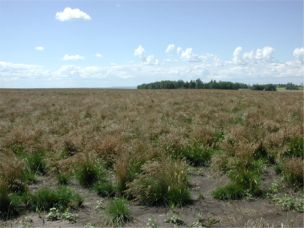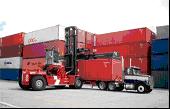| | Introduction | Marketing alternatives | Cash market | Contracts | Summary | Return to Special Commodity Marketing page
.
Introduction
Creeping red fescue is a hardy, low growing, creeping rooted grass that will form a dense sod. It performs well on varying soil types, tolerates shady conditions and is primarily used as a turf grass. It is only one species of "fine-leaved" fescues, but is grown the most. Other fine leaf fescues include: "Sheeps", "rough", "chewings", and "hard".

Creeping Red Fescue Seed Field
Creeping red fescue is used:
- For turf purposes in lawn mixtures around homes, buildings, and in parks. Most creeping red fescue is mixed with US grown perennial ryegrass and Kentucky bluegrass as a turf mixture. Prices and availability for other "cool-season" turf grasses determine amounts of fescue going into a mixture. Besides perennial ryegrass and Kentucky bluegrass, other turf grass species used in mixtures include tall fescue and annual ryegrass. Warm season turf grass species used for turf include Bermuda grass and some bahai grass species.
- For conservation uses, fescue is used to seed roadsides, irrigation ditches, right-of-ways and other disturbed areas. For pasture in mixes or alone in high traffic areas. Creeping red fescue is palatable, and has early spring and persistent fall growth. It is considered to be one of the better species for late fall or dormant grazing as it tends to hold its feed quality well.
- In Canada, virtually all the creeping red fescue production is grown in the Peace River region of Alberta and British Columbia. Seed production can vary from year to year, due to weather or other factors. Most Canadian creeping red fescue is exported. The United States is the largest market and accounts for over 85% of creeping red fescue exports.
| Canadian Exports of Forage Seeds | 2010 | 2011 | 2012 | 2013 | 2014 |
| Creeping Red Exports to USA | 8.5 | 8.8 | 9.2 | 10.3 | 8.3 |
| Total Creeping Red Fescue Exports - World | 9.0 | 11.0 | 11.7 | 11.4 | 9.2 |
 |  |  |  |  |  |
| Export Figures in Millions of Kg's |
Canada faces competition from other parts of the world in growing turf grass seed. Creeping red fescue production also occurs in Denmark and Oregon, USA. Although significant in Canada, world creeping red fescue seed production pales in comparison to perennial ryegrass and tall fescue.
Regardless of how the fescue crop will be sold, producers should grow a quality product. New herbicides allow farmers to remove grassy weeds from fescue. Producing a crop free of other grasses and weeds will usually be rewarded with higher returns per pound.
Marketing Alternatives
There are marketing alternatives available to growers when selling fescue. As a producer you can use either 1) the cash market, 2) contract your crop, or 3) broker your crop. Within these methods, companies offer a number of specific alternatives.
Cash Market
The majority of seed still changes hands on the cash market, where various buyers quote a price. Here you must decide whether or not to sell. As a producer, you can phone a number of companies to find out who is buying and at what price. If the offer is acceptable, a sale is made. If the price is unacceptable, you may store the seed until prices improve.
Storage is commonplace among fescue seed growers. Seed quality, when properly harvested, does not deteriorate for a number of years. However, before storing, producers must consider their cash flow needs, the cost of carrying inventories, and storage requirements. These factors must offset any expected gains from selling at a higher price.

Export fescue is generally bagged,
containerized and shipped bulk.
Contracts
Contracting is a means of assuring a market for your production. They also allow growers for delivery opportunities, which may be valuable in years with poor seed movement. Seed companies offer two basic contracts: production contracts or deferred delivery contracts.
Production contracts: Companies usually offer production contracts for certified seed production. These contracts are based on production per acre, using either a fixed price per lb. or, more commonly, based on the cash price for fescue during some period near the time of sale. For example, the price may be established as the average price for Common #1 seed from October to November in the crop year in question. A quality premium may also be in place.
If a private variety is contracted, a price may be established at the time the contract is signed. The price may be outright, or based on some standard variety, such as Boreal. For example, the price may be set at Boreal, plus five cents per pound. With most production contracts, the acreage is specified. A Production contract may cover seed production for several years into the future.
Deferred delivery contracts: These are usually fixed in terms of price to growers and in terms of volume. Deferred delivery contracts are usually for crop that is not yet harvested, but they may also be written for crop in the bin. If the deferred delivery contract is for a growing crop, you should only contract a portion of your normal expected yield. Deferred delivery type contracts can be used to reduce price risk and lock in a profit on a portion of expected production, or take advantage of an acceptable price if immediate delivery is not possible.
When contracting, some things to be considered include:
- How will an average price be determined?
- Is a simple average used?, or an average of the volume purchased by the company over the stated period?
- Is it the price paid by the contracting company their quoted price or an industry average?
- How is dockage determined and by whom?
- How will the price be affected by a lower grade?
Brokered seed
Some forage seed processors will custom clean fescue seed and hold it until such time as the grower agrees to sell. The farmer must pay the storage and cleaning charges. These operations operate as brokers, trying to work deals that are acceptable to their farmer clients. Forage seed brokers arrange seed sales by putting buyers and sellers together and helping negotiate a price. The broker does not take ownership of the seed. In a brokered sale, the grower retains ownership of the seed until the purchaser receives it. The broker merely acts as an intermediary between the grower and an interested buyer. Since the majority of creeping red fescue is destined for the export market, seed quality and proper certificates must be managed. Export sales usually involve large quantities of seed. Non-custom cleaning brokers will charge a fee for their services. Custom cleaners who broker seed on behalf of their clients may not charge, as long as you use their seed processing facilities. Because brokers do not take ownership of the product, they are not legally responsible for assuring that growers are paid. Some brokers arrange freight, customs clearances, and sanitary or purity certificates if required. If the broker does not make these arrangements, then the seller must make them. In all cases, the grower must cover the costs of freight, customs, and special certificates.
Summary
Current growers and potential growers should be aware of historical prices for fescue and budget accordingly. Knowledge of what a long- term average price is can be helpful in developing a marketing strategy. Historical prices.
The type of marketing plan a creeping red fescue grower will partake in will depend upon each individual grower. Growing a productive creeping red fescue crop is only one part of the management process. Selling it is another. The best marketing choice for growers will depend largely on their willingness and ability to accept risk. Remember, every company and contract may be different. Contracts are legally binding documents. Producers entering contracts must know what they are signing and the obligations and responsibilities of each party to the agreement. |
|